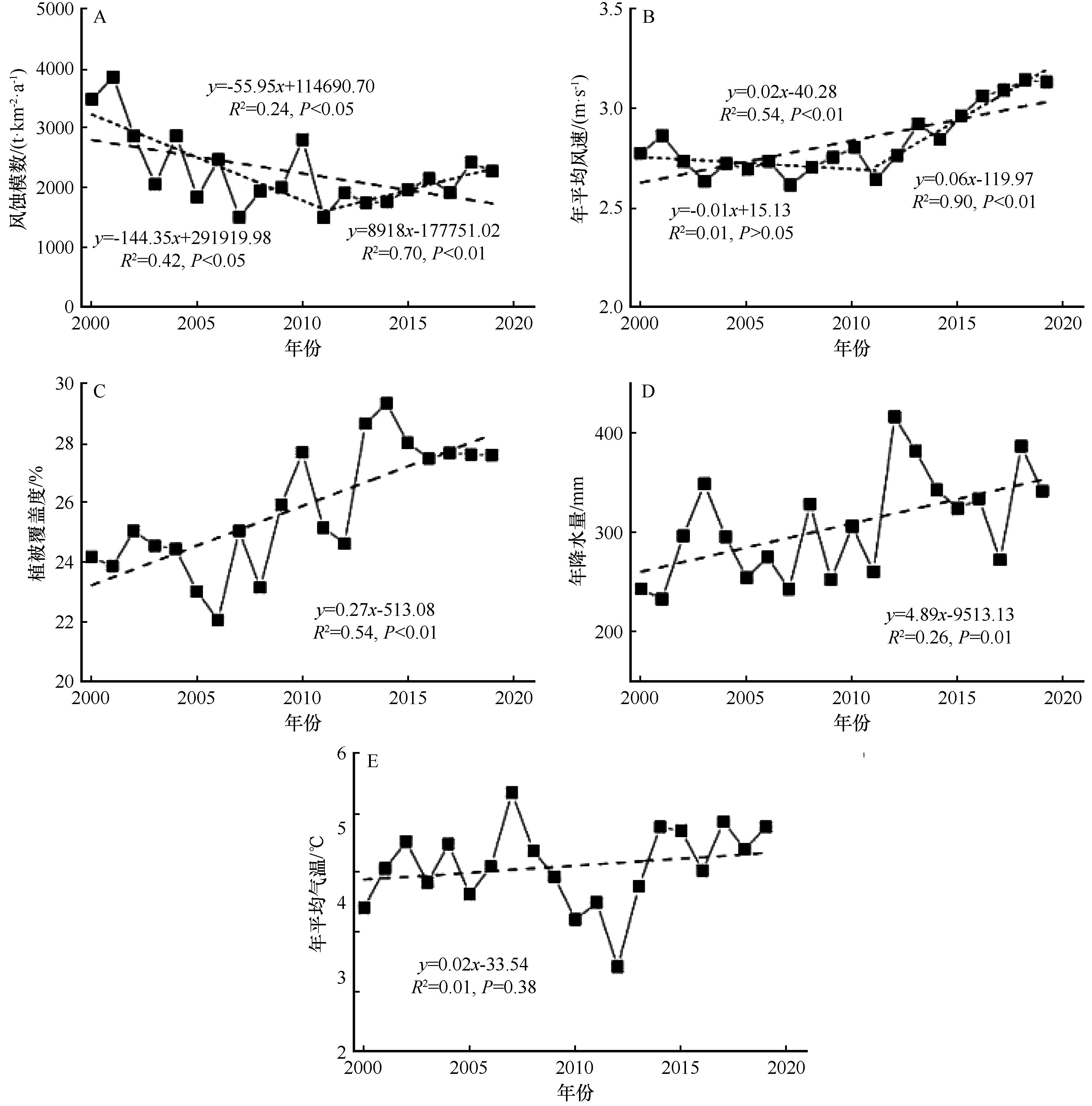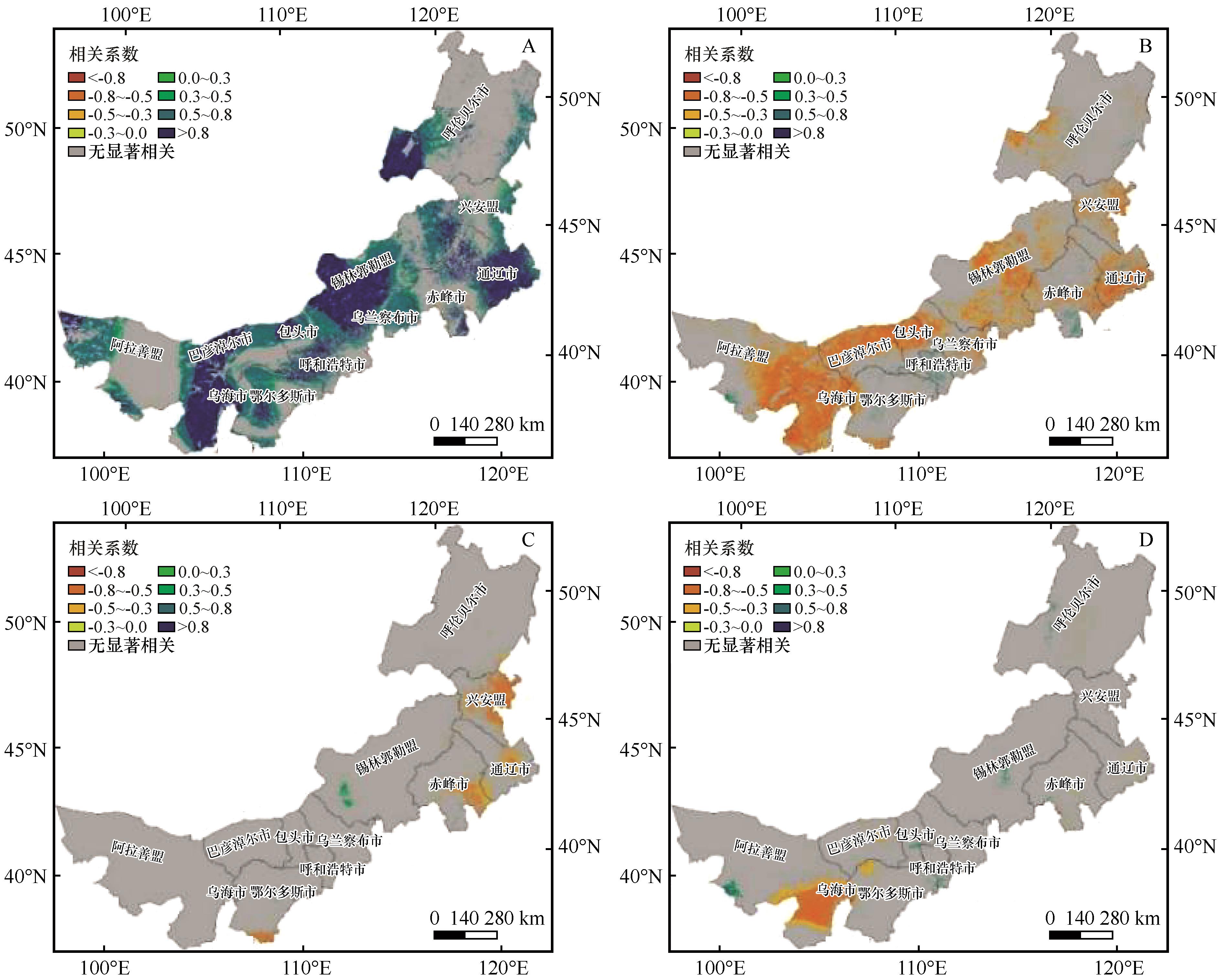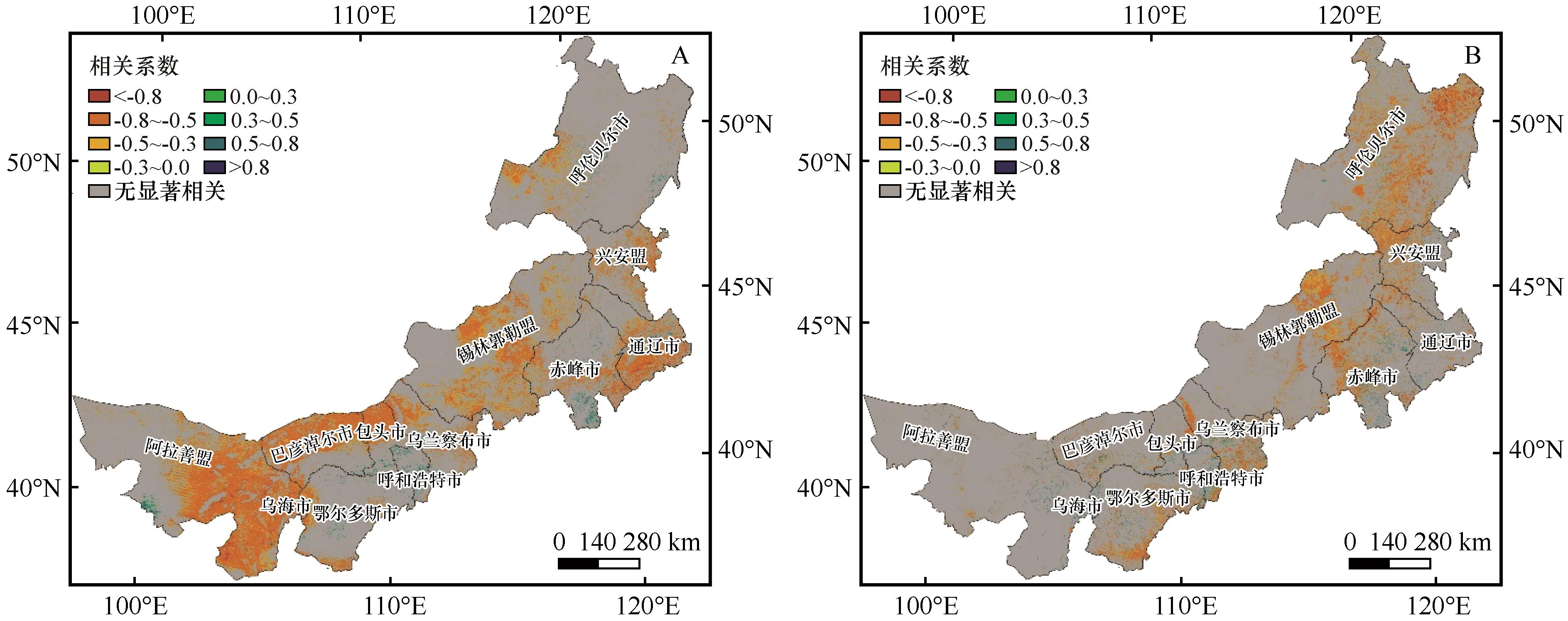
- CN 62-1070/P
- ISSN 1000-694X
- Bimonthly 1981

Journal of Desert Research ›› 2024, Vol. 44 ›› Issue (1): 178-188.DOI: 10.7522/j.issn.1000-694X.2023.00077
Qing Li1( ), Na Zhou2, Sheng Wang3, Tongzhou Li1, Rende Wang1, Jinfeng Wang3
), Na Zhou2, Sheng Wang3, Tongzhou Li1, Rende Wang1, Jinfeng Wang3
Received:2023-07-16
Revised:2023-08-24
Online:2024-01-20
Published:2023-12-26
CLC Number:
Qing Li, Na Zhou, Sheng Wang, Tongzhou Li, Rende Wang, Jinfeng Wang. Quantitative assessment the impacts of climate change and human actives on wind erosion: a case study of Inner Mongolia Autonomous Region[J]. Journal of Desert Research, 2024, 44(1): 178-188.
Add to citation manager EndNote|Ris|BibTeX
URL: http://www.desert.ac.cn/EN/10.7522/j.issn.1000-694X.2023.00077
| 名称 | 分辨率/比例尺 | 时间 | 数据来源 |
|---|---|---|---|
| NDVI | 1 km×1 km | 2000—2019年 | https://ladsweb.modaps.eosdis.nasa.gov/search/ |
| 表土湿度数据 | 0.25°×0.25° | 2000—2019年 | https://search.earthdata.nasa.gov/search |
| 土地利用数据 | 1 km×1 km | 2000、2005、2010、2015年 | https://www.resdc.cn/ |
| 土壤类型数据 | 1 km×1 km | https://www.resdc.cn/ | |
| 小时风速、月降水量、月平均气温 | 气象站点 | 2000—2019年 | http://data.cma.cn/ |
Table 1 Data sources in this study
| 名称 | 分辨率/比例尺 | 时间 | 数据来源 |
|---|---|---|---|
| NDVI | 1 km×1 km | 2000—2019年 | https://ladsweb.modaps.eosdis.nasa.gov/search/ |
| 表土湿度数据 | 0.25°×0.25° | 2000—2019年 | https://search.earthdata.nasa.gov/search |
| 土地利用数据 | 1 km×1 km | 2000、2005、2010、2015年 | https://www.resdc.cn/ |
| 土壤类型数据 | 1 km×1 km | https://www.resdc.cn/ | |
| 小时风速、月降水量、月平均气温 | 气象站点 | 2000—2019年 | http://data.cma.cn/ |
| 情景 | SA | SC | SH | 情景描述 | |
|---|---|---|---|---|---|
| 情景1 | >0 | >0 | <0 | 风蚀增强由气候变化引起 | |
| 情景2 | >0 | <0 | >0 | 风蚀增强由人类活动引起 | |
| 情景3 | >0 | >0 | >0 | |SC|>|SH| | 风蚀增强主要由气候变化引起 |
| 情景4 | >0 | >0 | >0 | |SC|<|SH| | 风蚀增强主要由人类活动引起 |
| 情景5 | <0 | >0 | <0 | 风蚀减弱由人类活动引起 | |
| 情景6 | <0 | <0 | >0 | 风蚀减弱由气候变化引起 | |
| 情景7 | <0 | <0 | <0 | |SC|>|SH| | 风蚀减弱主要由气候变化引起 |
| 情景8 | <0 | <0 | <0 | |SC|<|SH| | 风蚀减弱主要由人类活动引起 |
Table 2 Eight scenarios for the relative effects of climate change and human activities on wind erosion variation
| 情景 | SA | SC | SH | 情景描述 | |
|---|---|---|---|---|---|
| 情景1 | >0 | >0 | <0 | 风蚀增强由气候变化引起 | |
| 情景2 | >0 | <0 | >0 | 风蚀增强由人类活动引起 | |
| 情景3 | >0 | >0 | >0 | |SC|>|SH| | 风蚀增强主要由气候变化引起 |
| 情景4 | >0 | >0 | >0 | |SC|<|SH| | 风蚀增强主要由人类活动引起 |
| 情景5 | <0 | >0 | <0 | 风蚀减弱由人类活动引起 | |
| 情景6 | <0 | <0 | >0 | 风蚀减弱由气候变化引起 | |
| 情景7 | <0 | <0 | <0 | |SC|>|SH| | 风蚀减弱主要由气候变化引起 |
| 情景8 | <0 | <0 | <0 | |SC|<|SH| | 风蚀减弱主要由人类活动引起 |

Fig.6 Variation trend of wind erosion modulus (A), mean wind speed (B), vegetation coverage (C), precipitation (D), and mean temperature (E) in Inner Mongolia Autonomous Region from 2000 to 2019

Fig.7 Relations of wind speed (A), vegetation coverage (B), precipitation (C), and temperature (D) and wind erosion modulus for climate-driven and climate-dominate-driven area

Fig.8 Relations of vegetation coverage and wind erosion modulus for climate-driven and climate-dominate-driven area (A) and human-driven and human-dominate-driven area (B)
| 土地利用不变类型 | 土地利用变化类型 | |
|---|---|---|
| 风蚀风险加重类 | 风蚀风险减弱类 | |
| 耕地 | 林地草地不可蚀土地未利用地转耕地 | 沙地转耕地 |
| 林地 | 不可蚀土地转林地 | 耕地草地沙地未利用地转林地 |
| 草地 | 林地不可蚀土地转草地 | 耕地沙地未利用地转草地 |
| 沙地 | 耕地林地草地不可蚀土地未利用地转沙地 | 耕地林地草地沙地未利用地转不可蚀土地 |
| 未利用地 | 林地草地不可蚀土地转未利用地 | 耕地沙地转未利用地 |
Table 3 Classifications of land use change from 2000 to 2015
| 土地利用不变类型 | 土地利用变化类型 | |
|---|---|---|
| 风蚀风险加重类 | 风蚀风险减弱类 | |
| 耕地 | 林地草地不可蚀土地未利用地转耕地 | 沙地转耕地 |
| 林地 | 不可蚀土地转林地 | 耕地草地沙地未利用地转林地 |
| 草地 | 林地不可蚀土地转草地 | 耕地沙地未利用地转草地 |
| 沙地 | 耕地林地草地不可蚀土地未利用地转沙地 | 耕地林地草地沙地未利用地转不可蚀土地 |
| 未利用地 | 林地草地不可蚀土地转未利用地 | 耕地沙地转未利用地 |
| 1 | Zhang H, Fan J, Cao W,et al.Response of wind erosion dynamics to climate change and human activity in Inner Mongolia,China during 1990 to 2015[J].Science of the Total Environment,2018,639:1038-1050. |
| 2 | Lin J, Guan Q, Pan N,et al.Spatiotemporal variations and driving factors of the potential wind erosion rate in the Hexi region,PR China[J].Land Degradation & Development,2021,32(1):139-157. |
| 3 | Lee J J, Phillips D L, Benson V W.Soil erosion and climate change: assessing potential impacts and adaptation practices[J].Journal of Soil and Water Conservation,1999,54(3):529-536. |
| 4 | Zhao Y, Wu J, He C,et al.Linking wind erosion to ecosystem services in drylands: a landscape ecological approach[J].Landscape Ecology,2017,32(12):2399-2417. |
| 5 | Sharratt B S, Tatarko J, Abatzoglou J T,et al.Implications of climate change on wind erosion of agricultural lands in the Columbia plateau[J].Weather and Climate Extremes,2015,10:20-31. |
| 6 | Dupont S, Bergametti G, Simoëns S.Modelling aeolian erosion in presence of vegetation[J].Procedia IUTAM,2015,17:91-100. |
| 7 | Pierre C, Kergoat L, Hiernaux P,et al.Impact of agropastoral management on wind erosion in sahelian croplands[J].Land Degradation & Development,2018,29(3):800-811. |
| 8 | Du H, Zuo X, Li S,et al.Wind erosion changes induced by different grazing intensities in the desert steppe,Northern China[J].Agriculture,Ecosystems & Environment,2019,274:1-13. |
| 9 | Gong G, Liu J, Shao Q,et al.Sand-fixing function under the change of vegetation coverage in a wind erosion area in northern China[J].Journal of Resources and Ecology,2014,2(5):105-114. |
| 10 | Zhao C, Zhang H, Wang M,et al.Impacts of climate change on wind erosion in Southern Africa between 1991 and 2015[J].Land Degradation & Development,2021,32(6):2169-2182. |
| 11 | Zhang H, Peng J, Zhao C,et al.Wind speed in spring dominated the decrease in wind erosion across the Horqin Sandy Land in northern China[J].Ecological Indicators,2021,127:107599. |
| 12 | Teng Y, Zhan J, Liu W,et al.Spatiotemporal dynamics and drivers of wind erosion on the Qinghai-Tibet Plateau,China[J].Ecological Indicators,2021,123:107340. |
| 13 | Ma J, Li R, Yang Y,et al.Spatial heterogeneity of driving factors of wind erosion prevention services in Northern China by Large-Scale Human Land-Use Management[J].Land,2022,11(1):111. |
| 14 | Li D, Xu E, Zhang H.Influence of ecological land change on wind erosion prevention service in arid area of northwest China from 1990 to 2015[J].Ecological Indicators,2020,117:106686. |
| 15 | Li D, Xu D, Wang Z,et al.The dynamics of sand-stabilization services in Inner Mongolia,China from 1981 to 2010 and its relationship with climate change and human activities[J].Ecological Indicators,2018(88):351-360. |
| 16 | Jiang L, Xiao Y, Zheng H,et al.Spatio-temporal variation of wind erosion in Inner Mongolia of China between 2001 and 2010[J].Chinese Geographical Science,2016,26(2):155-164. |
| 17 | Chi W, Zhao Y, Kuang W,et al.Impacts of anthropogenic land use/cover changes on soil wind erosion in China[J].Science of the Total Environment,2019,668:204-215. |
| 18 | Du H, Liu X, Jia X,et al.Assessment of the effects of ecological restoration projects on soil wind erosion in northern China in the past two decades[J].Catena,2022,215:106360. |
| 19 | Wei X, Wu X, Wang D,et al.Spatiotemporal variations and driving factors for potential wind erosion on the Mongolian Plateau[J].Science of the Total Environment,2023,862:160829. |
| 20 | Wu J, Zheng X, Zhao L,et al.Effects of ecological programs and other factors on soil wind erosion between 1981-2020[J].Remote Sensing,2022,14:5322. |
| 21 | Wessels K J, Prince S D, Frost P E,et al.Assessing the effects of human-induced land degradation in the former homelands of northern South Africa with a 1 km AVHRR NDVI time-series[J].Remote Sensing of Environment,2004,91(1):47-67. |
| 22 | Sun Y, Yang Y, Zhang L,et al.The relative roles of climate variations and human activities in vegetation change in North China[J].Physics and Chemistry of the Earth,Parts A/B/C,2015(87/88):67-78. |
| 23 | Qi X, Jia J, Liu H,et al.Relative importance of climate change and human activities for vegetation changes on China's silk road economic belt over multiple timescales[J].Catena,2019,180:224-237. |
| 24 | Li A, Wu J, Huang J.Distinguishing between human-induced and climate-driven vegetation changes: a critical application of RESTREND in Inner Mongolia[J].Landscape Ecology,2012,27(7):969-982. |
| 25 | Herrmann S M, Anyamba A, Tucker C J.Recent trends in vegetation dynamics in the African Sahel and their relationship to climate[J].Global Environmental Change,2005,15(4):394-404. |
| 26 | Evans J, Geerken R.Discrimination between climate and human-induced dryland degradation[J].Journal of Arid Environments,2004,57(4):535-554. |
| 27 | Cai H, Yang X, Xu X.Human-induced grassland degradation/restoration in the central Tibetan Plateau: the effects of ecological protection and restoration projects[J].Ecological Engineering,2015,83:112-119. |
| 28 | 李苗苗,吴炳方,颜长珍,等.密云水库上游植被覆盖度的遥感估算[J].资源科学,2004(4):153-159. |
| 29 | 程宏,蒋宁,张恺笛,等.京津风沙源地表沙尘释放及其区域分异[J].科学通报,2023,68(11):1356-1366. |
| 30 | 高尚玉,张春来,邹学勇,等.京津风沙源治理工程效益[M].北京:科学出版社,2008. |
| 31 | Yang H, Chang Q, Du M,et al.Quantitative model of soil erosion rates using 137Cs for uncultivated soil[J].Soil Science,1998,163(3):248-257. |
| 32 | 中华人民共和国水利部.土壤侵蚀分类分级标准SL190-2007[M].北京:中国水利水电出版社,2008. |
| 33 | 邹学勇,张春来,程宏,等.土壤风蚀模型中的影响因子分类与表达[J].地球科学进展,2014,29(8):875-889. |
| 34 | 吴正.风沙地貌与治沙工程学[M].北京:科学出版社,2003. |
| 35 | Wolfe S A, Nickling W G.The protective role of sparse vegetation in wind erosion[J].Progress in Physical Geography:Earth and Environment,1993,17(1):50-68. |
| 36 | 邢恩德,马少薇,郭建英,等.植被盖度对典型草原区地表风沙流结构及风蚀量影响[J].水土保持研究,2015,22(6):331-334. |
| 37 | Lancaster N, Baas A.Influence of vegetation cover on sand transport by wind: field studies at Owens Lake,California[J].Earth Surface Processes and Landforms,1998,23(1):69-82. |
| [1] | Wenru Jia, Qing Li, Xiuming Li, Baoni Xie, Cui Wang. The spatial and temporal variation of soil wind erosion modulus in the Baishan region of Hebei Province from 2000 to 2018 [J]. Journal of Desert Research, 2024, 44(1): 130-141. |
| [2] | Bin Wang, Qingjie Han, Bing Liu, Baheti Teliewuhan, Guli Sagen. The influence of sand surface temperature on wind erosion dynamic process [J]. Journal of Desert Research, 2023, 43(6): 10-19. |
| [3] | Yanzhuo Zhao, Yuanyun Xie, Chunguo Kang, Yunping Chi, Lei Sun, Peng Wu, Zhenyu Wei. Holocene climate change recorded by paleosoil profile in Hulun Buir Sandy Land [J]. Journal of Desert Research, 2023, 43(5): 85-96. |
| [4] | Yali Ma, Zhiduo Wang, Jiaqiong Zhang, Yusuo Xu, Yuanyuan Li. Effect of moss crust coverage and spatial distribution on soil wind erosion using wind tunnel experiments and simulations [J]. Journal of Desert Research, 2023, 43(5): 97-107. |
| [5] | Jianbing Lu, Ke Ju, Weibin Liao. Variation in NDVI and its response to climate change and human activities in Gansu Province during 2000-2020 [J]. Journal of Desert Research, 2023, 43(4): 118-127. |
| [6] | Jinfeng Wang, Xiaoling Liu, Qing Li, Rende Wang, Sheng Wang. Spatio-temporal differentiation and driving factors of windbreak and sand fixation services in wind erosion area of the northern Loess Plateau [J]. Journal of Desert Research, 2023, 43(4): 220-230. |
| [7] | Qi You, Baorong Xu, Songbing Zou, Yihao Qin, Duo Wang, Dong Yu. The vegetation-climate quantitative relationship and characteristics in arid and semi-arid region of northern China [J]. Journal of Desert Research, 2023, 43(4): 274-287. |
| [8] | Yaozong Wang, Xinbin Yue, Jiali Xie, Zhipeng Liu, Yuan Ma, Yahui Wang, Yan Gong. Desertification evolution in the sandy region to the east of the Yellow River in Ningxia from 2000 to 2020 [J]. Journal of Desert Research, 2023, 43(4): 31-40. |
| [9] | Rui Guo, Wei Liu, Zongxing Li, Ya Wang, Yong Chen, Lihua Zhou. An analysis on the land use change characteristics and driving forces in Gansu part of the Qilian Mountain [J]. Journal of Desert Research, 2023, 43(3): 188-198. |
| [10] | Pengfei Liang, Huijuan Xin, Zongxing Li, Fusen Nan, Biao Tang, Wenbao Zhang. Study on the attribution of runoff variation in the Danghe River based on the Budyko hypothesis [J]. Journal of Desert Research, 2023, 43(3): 210-219. |
| [11] | Wenfeng Chi, Yuetian Wang, Xiaohong Dang, Xiaoguang Wu, Qiancheng Luo. Temporal variation and spatial pattern of soil erosion in the Yellow River Basin [J]. Journal of Desert Research, 2023, 43(3): 305-317. |
| [12] | Ran Duan, Zongjie Li, Yu Wang, Xiaoying Liu, Juan Gui, Pengfei Liang, Yuchen Li, Jian Xue, Mengqing Liu, Bin Xu. Characteristics of runoff change in the Shiyang River Basin [J]. Journal of Desert Research, 2023, 43(3): 57-68. |
| [13] | Ziyan Han, Jijun Meng, Yi Zou, Likai Zhu. Vegetation dynamics and their response to climate change and ecological protection projects in the Heihe River Basin from 1982 to 2017 [J]. Journal of Desert Research, 2023, 43(3): 96-106. |
| [14] | Chunming Xin, Mingzhu He, Chengyi Li, Libin Zhang, Xinrong Li. A review of research progress on nitrous oxide emissions from desert soil and its driving factors [J]. Journal of Desert Research, 2023, 43(2): 184-194. |
| [15] | Hong Sun, Jiyun Duan, Yujie Liu, Ruilan Ran, Xiaofeng Li, Pengshan Zhao. Potential distribution of the genus Agriophyllum under climate change [J]. Journal of Desert Research, 2023, 43(2): 255-263. |
| Viewed | ||||||
|
Full text |
|
|||||
|
Abstract |
|
|||||
©2018Journal of Desert Research
Tel:0931-8267545
Email:caiedit@lzb.ac.cn;desert@lzb.ac.cn
Support:Magtech